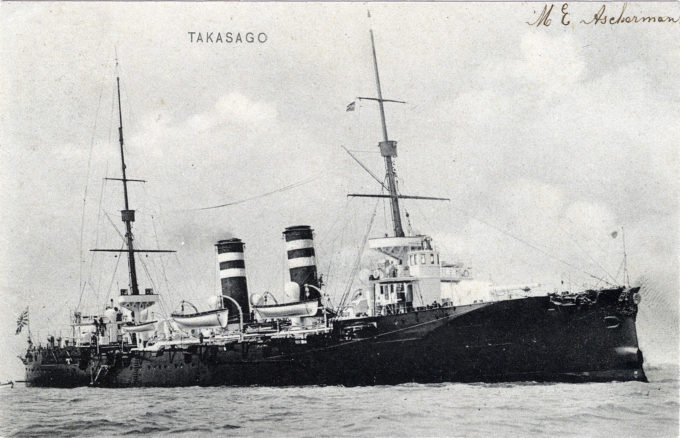
Imperial Japanese Navy Cruiser Takasago, c. 1900. Although well protected with 109 watertight compartments and a double bottom hull, Takasago was sunk by a mine in December 1904 during the Russo-Japanese War.
See also:
Imperial Japanese Navy Armored Cruiser “Azuma”, c. 1910.
Imperial Japanese Navy Heavy Cruiser “Takao” Commemorative, 1930.
Russo-Japanese War (1904-1905).
“Takasago (高砂, literally, High Sand, an antiquated Japanese name for Formosa) was a protected cruiser of the Imperial Japanese Navy, designed and built by the Armstrong Whitworth shipyards in Elswick, in the United Kingdom. Takasago was the last major Japanese warship lost in the Russo-Japanese War.
“Takasago was an improved design of the Argentine Navy cruiser Veinticinco de Mayo designed by Sir Philip Watts, who was also responsible for the design of the cruiser Izumi and the Naniwa-class cruisers. Takasago was laid down in April 1896, as Elswick hull number 660, as a private venture by Armstrong Whitworth. Sold to Japan in July 1896, she was launched on 18 May 1897 and completed on 6 April 1898.
“The first overseas deployment of Takasago was in 1900, to support Japanese naval landing forces occupying the port city of Tianjin in northern China during the Boxer Rebellion, as part of Japan’s contribution to the Eight-Nation Alliance.
“On 7 April 1902, Takasago and Asama were sent on a 24,718 nautical miles (45,778 km; 28,445 mi) voyage to the United Kingdom, as part of the official Japanese delegation to the coronation ceremonies of King Edward VII, and in celebration of the Anglo-Japanese Alliance. After participating in a naval review held at Spithead on 16 August 1902, Takasago and Asama visited numerous European and Asian ports (Singapore, Colombo, Suez, Malta, Lisbon on the way, Antwerp and Cork during their stay, and Gibraltar, Naples, Aden, Colombo, Singapore, Bangkok and Hong Kong on the way back).
“With the start of the Russo-Japanese War of 1904–1905, Takasago participated in the bombardment of the Port Arthur naval base on the morning following the pre-emptive strike by Japanese destroyers against the Russian fleet in the opening stages of the naval Battle of Port Arthur, serving as flagship for Admiral Dewa Shigeto. The Japanese attack set fire to a portion of the town, and damaged a number of ships in the harbor, especially the cruisers Novik, Diana and Askold, and the battleship Petropavlovsk. While participating in the subsequent blockade of the Russian fleet within the confines of the harbor, Takasago captured the Russian Far East Shipping Company merchant ship Manchuria, which was accepted into Japanese service as a prize of war and renamed Kantō Maru.
“On 10 March 1904, Takasago participated in an attack on the Russian cruiser Bayan. On 15 May, she participated in the rescue of survivors from the battleships Yashima and Hatsuse, which had struck naval mines. Takasago was also in the Battle of the Yellow Sea on 10 August.
“She returned to Japan for overhaul in October 1904. On returning to station on the night of 13 December 1904 after a reconnaissance mission during which it provided cover for a squadron of destroyers, Takasago struck a naval mine 37 nautical miles (69 km; 43 mi) south of Port Arthur, which triggered a massive explosion in her ammunition magazine. The flooding could not be controlled, and her life boats could not be launched at night under blizzard conditions and heavy seas. Takasago sank in position 38°10′N 121°15′ECoordinates: 38°10′N 121°15′E, with the loss of 273 officers and crew. Some 162 survivors were rescued by the accompanying cruiser Otowa.”
– Wikipedia

